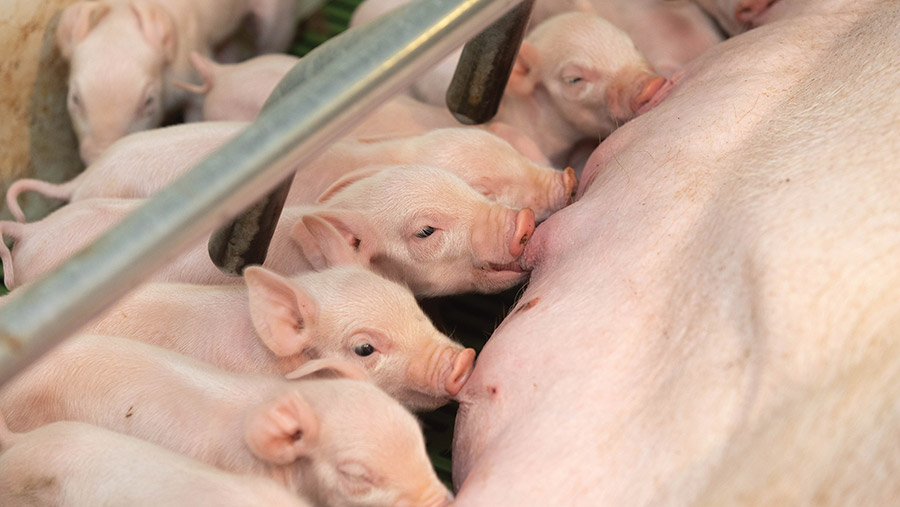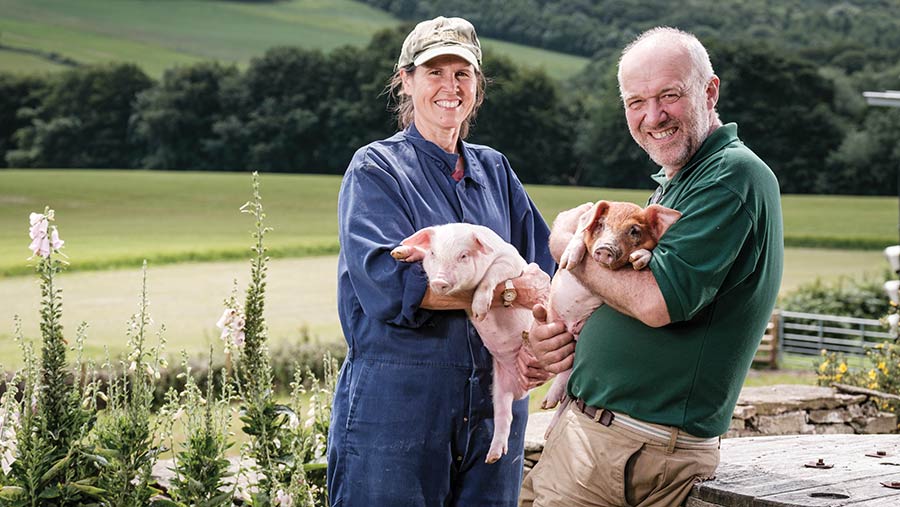7 ways to encourage a healthy gut microbiome in pigs
 © Tim Scrivener
© Tim Scrivener Ahealthy gut microbiome is the starting point for good pig health, say producers Karen and Stephen Thompson.
They run a 200-sow indoor herd on a three-week batch system in south Yorkshire.
Since compulsory recording via the e-medicine book (eMB-Pigs) began, average annual antibiotics use on the unit has been about 4mg/kg, with only the occasional increase and never above 8mg/kg.
See also: 5 ways to keep disease out of outdoor pig herds
Farm facts: Povey Farm, Sheffield
- 200-sow indoor farrow-to-finish herd
- Own wholesale butchery business, Moss Valley Fine Meats
- Three-week batch system

Karen and Stephen Thompson © Jim Varney
Karen’s animal science degree sparked her curiosity about nutrition and microbiology.
It gave her the foundations to keep learning about the developing science of gut health and questioning how they might apply it to make improvements on farm.
Here, she shares some of the key ways she and Stephen encourage a healthy gut microbiome in their herd.
1. Maintain a healthy gut for strong immunity
“The gut is doing so much more than absorbing nutrients,” says Karen.
“For example, there is increasing evidence that maintaining a rich gut microbiome in our pigs is crucial to a strong immune response to any disease challenges.
“However, using an antibiotic weakens the gut microbiome by stripping out a few [good] species of bacteria, along with those it is there to treat, upsetting the balance and potentially causing a further problem.
“It is difficult for the gut microbiome to fully recover in the short lifetime of a pig.”
Every farm is different, trying out alternatives can be daunting or tricky to fit in, and the tangible rewards might not be seen immediately, she adds.
However, the rise in antibiotics-resistant bacteria in human medicine is a compelling reason to keep going with efforts to reduce antibiotics use in pigs.
“Talk to both the vet and nutritionist and investigate options – a nutritionist is as valuable as the vet to a pig farm.”
2. To help the piglet, start with the sow
The richer the sow’s gut microbiome, the richer the piglet’s is likely to be, with research in humans showing that a baby receives an initial inoculation of gut microflora from its mother at birth.
Sows are fed the live yeast prebiotic Levucell throughout the productive cycle, from maiden gilt to slaughter.
The Thompsons began using this to help combat clostridial infection that was causing sudden death in sows.
They were previously vaccinating against it, which helped reduce problems, but now they rarely lose a sow.
The yeast stops clostridium from taking hold in the gut and, by using it in sow diets, it also provides a “starter culture” to newborn piglets.
Dietary fibre is another crucial element for overall gut health. Almost all of the sows and growing pigs are fed a meal-based diet, milled on farm by Harbro.
Dietary fibre is important because it supplies an energy source for gut bacteria.
Home-milling makes it easier to work with the nutritionist to try different supplements or adjust nutrients.
3. Train the piglet to eat before weaning
Training the piglet to eat before weaning, and keeping it eating, is paramount.
“If piglets do not keep enough food in the gut at weaning, it can predispose them to problems such as E coli infection,” says Karen.
Piglets are fed supplementary milk daily from day two, including Top Gut, a probiotic containing Clostridium butyricum – a beneficial clostridial strain.
It is currently fed manually, but she says the labour is worthwhile for three reasons:
- Additional milk produces a heavier piglet at weaning
- Litters are more uniform, as smaller piglets can access feed and cope more easily
- The piglet learns at an early age that there is an alternative food source to the sow and is more independent.
At two weeks, piglets transition from supplementary milk to a “milky” cereal product, Fostercare, which the Thompsons mix up in a bucket.
This gets the piglets chewing. It is cheaper than milk, gentle on the gut and stimulates it in readiness to digest more cereal.
Top Gut continues to be provided until after weaning.
Piglets also receive a high-quality creep feed. This is kept fresh by offering it little and often, from day eight, twice a day.
The Thompsons removed all medicinal zinc from weaned piglet diets last September and, so far, this has been a success.
However, veterinary and nutritional advice should be taken before trialling diets without zinc.
4. Manage weaning carefully for a strong start
Weaned piglets are moved into a clean, warm environment in pens of 50-55 pigs, with plenty of access to food and water.
For the first week or so, they are fed an additional gruel of creep crumb and water mixed by hand via two Porcimax feeders in each pen.
They are a larger version of the creep feeders already familiar to the piglets.
Feeding takes three minutes, three times a day for the first five days, then it is provided twice a day until day seven, continuing for the smallest 30% of pigs until day nine.
5. Test before treating a health issue
It is vital to send samples for lab testing whenever possible to find out exactly what is causing a health problem.
This ensures the most effective treatment is given, and antibiotics are only used when needed.
The Thompsons treat individual piglets with antibiotics in the farrowing and weaning pens, rather than the whole litter or group and only the severe cases.
]In a recent occurrence of scouring in some weaner pigs, they injected only the 12 affected piglets (out of 350), with no subsequent deaths.
For less severe scouring in pre-weaned piglets, they are now trying Fibercombi, a hygiene powder they put anywhere the piglets will ingest it, for example, on feeders or sows’ udders.
Based on potato starch, it helps keep the gut environment healthy and appears to help piglets recover quickly.
6. Put measures in place to keep disease out
The Thompsons are fortunate they are not in a pig-dense region.
They minimise the risk of disease being brought on farm in the following ways:
- Visitors are required to be three days pig-free
- Wellies are provided in a range of sizes for anyone coming on to the farm
- Lorry drivers are not allowed to wander around the unit, and when loading pigs, the Thompsons make sure the driver stays on the ramp
- Clean, disinfected lorries deliver feed
- Staff on farm change or clean their boots and wash their hands when moving from older to younger pigs.
7. Vaccinate for preventative care
Vaccination, where needed, is an important part of the preventative approach.
As well as a comprehensive gilt and sow vaccination programme, the Thompsons vaccinate piglets at weaning against ileitis and have done so since a vaccine became available 20 years ago
